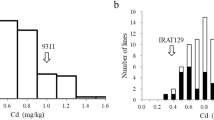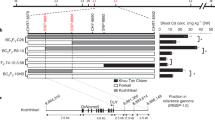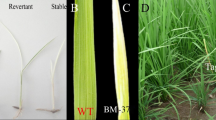Abstract
Barley is the fourth most produced cereal crop in the world and one of the major dietary sources of cadmium (Cd), which poses serious threats to human health. Here, we identify a gene that encodes a P-type heavy metal ATPase 3 (HvHMA3) responsible for grain Cd accumulation in barley. HvHMA3 from the high Cd barley variety Haruna Nijo in Japan and the low Cd variety BCS318 in Afghanistan shared 97% identity at the amino acid level. In addition, the HvHMA3 from both varieties showed similar transport activity for Cd and the same subcellular localization at the tonoplast. However, the expression of HvHMA3 was double in BCS318 than in Haruna Nijo. A 3.3-kilobase Sukkula-like transposable element was found to be inserted upstream of the gene in the low Cd variety, which functioned as a promoter and enhanced the expression of HvHMA3. Introgression of this insertion to an elite barley cultivar through backcrossing resulted in decreased Cd accumulation in the grain grown in Cd-contaminated soil without yield penalty. The decreased Cd accumulation resulting from the insertion was also found in some other barley landraces in the world. Our results indicate that insertion of the Sukkula-like transposable element plays an important role in upregulating HvHMA3 expression.
This is a preview of subscription content, access via your institution
Access options
Access Nature and 54 other Nature Portfolio journals
Get Nature+, our best-value online-access subscription
$29.99 / 30 days
cancel any time
Subscribe to this journal
Receive 12 digital issues and online access to articles
$119.00 per year
only $9.92 per issue
Buy this article
- Purchase on Springer Link
- Instant access to full article PDF
Prices may be subject to local taxes which are calculated during checkout






Similar content being viewed by others
Data availability
The data that support the findings of this study are available from the corresponding author upon request. Sequence data relating to this article have been registered in the DDBJ/GenBank/European Molecular Biology Laboratory databases (https://www.ddbj.nig.ac.jp) under the accession numbers LC523824 (HvHMA3-H), LC523825 (HvHMA3-B), LC523826 (HvHMA3-H_promoter) and LC523827 (HvHMA3-B_promoter).
References
Bertin, G. & Averbeck, D. Cadmium: cellular effects, modifications of biomolecules, modulation of DNA repair and genotoxic consequences (a review). Biochimie 88, 1549–1559 (2006).
Nawrot, T. et al. Environmental exposure to cadmium and risk of cancer: a prospective population-based study. Lancet Oncol. 7, 119–126 (2006).
Horiguchi, H. et al. Hypoproduction of erythropoietin contributes to anemia in chronic cadmium intoxication: clinical study on Itai-itai disease in Japan. Arch. Toxicol. 68, 632–636 (1994).
Zhao, F. J., Ma, Y., Zhu, Y. G., Tang, Z. & McGrath, S. P. Soil contamination in China: current status and mitigation strategies. Environ. Sci. Technol. 49, 750–759 (2015).
Clemens, S. & Ma, J. F. Toxic heavy metal and metalloid accumulation in crop plants and foods. Annu. Rev. Plant Biol. 67, 489–512 (2016).
Wang, W., Yamaji, N. & Ma, J. F. Molecular Mechanism of Cadmium Accumulation in Rice (eds Himeno, S. & Aoshima, K.) 115–124 (Springer, 2019).
Sasaki, A., Yamaji, N., Yokosho, K. & Ma, J. F. Nramp5 is a major transporter responsible for manganese and cadmium uptake in rice. Plant Cell 24, 2155–2167 (2012).
Yan, H. et al. Variation of a major facilitator superfamily gene contributes to differential cadmium accumulation between rice subspecies. Nat. Commun. 10, 2562 (2019).
Ueno, D. et al. Gene limiting cadmium accumulation in rice. Proc. Natl Acad. Sci. USA 107, 16500–16505 (2010).
Yamaji, N., Xia, J. X., Mitani-Ueno, N., Yokosho, K. & Ma, J. F. Preferential delivery of zinc to developing tissues in rice is mediated by P-type heavy metal ATPase OsHMA2. Plant Physiol. 162, 927–939 (2013).
Uraguchi, S. et al. Low-affinity cation transporter (OsLCT1) regulates cadmium transport into rice grains. Proc. Natl Acad. Sci. USA 108, 20959–20964 (2011).
Hao, X. et al. A node-expressed transporter OsCCX2 is involved in grain cadmium accumulation of rice. Front. Plant Sci. 9, 476 (2018).
Luo, J. S. et al. A defensin-like protein drives cadmium efflux and allocation in rice. Nat. Commun. 9, 645 (2018).
Schulte, D. et al. The international barley sequencing consortium—at the threshold of efficient access to the barley genome. Plant Physiol. 149, 142–147 (2009).
Codex General Standards for Contaminants and Toxins in Food and Feed (Codex Stan 193-1995) (Codex Alimentarius, FAO & WHO, 2019).
Chen, F. et al. Identification of barley genotypes with low grain Cd accumulation and its interaction with four microelements. Chemosphere 67, 2082–2088 (2007).
Wu, D., Sato, K. & Ma, J. F. Genome-wide association mapping of cadmium accumulation in different organs of barley. New Phytol. 208, 817–829 (2015).
Saisho, D., Myoraku, E., Kawasaki, S., Sato, K. & Takeda, K. Construction and characterization of a bacterial artificial chromosome (BAC) library from the Japanese malting barley variety ‘Haruna Nijo’. Breed. Sci. 57, 29–38 (2007).
Huang, C. F., Yamaji, N., Chen, Z. & Ma, J. F. A tonoplast-localized half-size ABC transporter is required for internal detoxification of aluminum in rice. Plant J. 69, 857–867 (2012).
Yan, J. et al. A loss-of-function allele of OsHMA3 associated with high cadmium accumulation in shoots and grain of Japonica rice cultivars. Plant Cell Environ. 39, 1941–1954 (2016).
Shirasu, K., Schulman, A. H., Lahaye, T. & Schulze-Lefert, P. A contiguous 66-kb barley DNA sequence provides evidence for reversible genome expansion. Genome Res. 10, 908–915 (2000).
Kartal-Alacam, G., Yilmaz, S., Marakli, S. & Gozukirmizi, N. Sukkula retrotransposon insertion polymorphisms in barley. Russ. J. Plant Physiol. 61, 828–833 (2014).
Wicker, T. et al. A unified classification system for eukaryotic transposable elements. Nat. Rev. Genet. 8, 973–982 (2007).
Pereira, J. F. & Ryan, P. R. The role of transposable elements in the evolution of aluminium resistance in plants. J. Exp. Bot. 70, 41–54 (2019).
Zhang, L. et al. A high-quality apple genome assembly reveals the association of a retrotransposon and red fruit colour. Nat. Commun. 10, 1494 (2019).
Fujii, M. et al. Acquisition of aluminium tolerance by modification of a single gene in barley. Nat. Commun. 3, 713 (2012).
Kashino-Fujii, M. et al. Retrotransposon insertion and DNA methylation regulate aluminum tolerance in European barley accessions. Plant Physiol. 178, 716–727 (2018).
Laxa, M. et al. The 5′UTR intron of Arabidopsis GGT1 aminotransferase enhances promoter activity by recruiting RNA polymerase II. Plant Physiol. 172, 313–327 (2016).
Yokosho, K., Yamaji, N., Fujii-Kashino, M. & Ma, J. F. Retrotransposon-mediated aluminum tolerance through enhanced expression of the citrate transporter OsFRDL4. Plant Physiol. 172, 2327–2336 (2016).
Lisch, D. How important are transposons for plant evolution? Nat. Rev. Genet. 14, 49–61 (2013).
Negi, P., Rai, A. N. & Suprasanna, P. Moving through the stressed genome: emerging regulatory roles for transposons in plant stress response. Front. Plant Sci. 7, 1448 (2016).
Pourkheirandish, M. et al. Evolution of the grain dispersal system in barley. Cell 162, 527–539 (2015).
Sasaki, A., Yamaji, N. & Ma, J. F. Overexpression of OsHMA3 enhances Cd tolerance and expression of Zn transporter genes in rice. J. Exp. Bot. 65, 6013–6021 (2014).
Cai, H., Huang, S., Che, J., Yamaji, N. & Ma, J. F. The tonoplast-localized transporter OsHMA3 plays an important role in maintaining Zn homeostasis in rice. J. Exp. Bot. 70, 2717–2725 (2019).
Close, T. J. et al. Development and implementation of high-throughput SNP genotyping in barley. BMC Genom. 10, 582 (2009).
Wang, S., Basten, C. J. & Zeng, Z. B. Windows QTL Cartographer 2.5 (Department of Statistics, North Carolina State University, 2012); http://statgen.ncsu.edu/qtlcart/WQTLCart.htm
Fuse, T., Sasaki, T. & Yano, M. Ti-plasmid vectors useful for functional analysis of rice genes. Plant Biotech. 18, 219–222 (2001).
Tsutsui, T., Yamaji, N. & Ma, J. F. Identification of a cis-acting element of ART1, a C2H2-type zinc-finger transcription factor for aluminum tolerance in rice. Plant Physiol. 156, 925–931 (2011).
Chen, S. et al. A highly efficient transient protoplast system for analyzing defence gene expression and protein–protein interactions in rice. Mol. Plant Pathol. 7, 417–427 (2006).
Hiei, Y., Ishida, Y., Kasaoka, K. & Komari, T. Improved frequency of transformation in rice and maize by treatment of immature embryos with centrifugation and heat prior to infection with Agrobacterium tumefaciens. Plant Cell Tiss. Org. Cult. 87, 233–243 (2006).
Hiei, Y. & Komari, T. Improved protocols for transformation of indica rice mediated by Agrobacterium tumefaciens. Plant Cell Tiss. Org. Cult. 85, 271–283 (2006).
Hensel, G., Valkov, V., Middlefell-Williams, J. & Kumlehn, J. Efficient generation of transgenic barley: the way forward to modulate plant–microbe interactions. J. Plant Physiol. 165, 71–82 (2008).
Miki, D. & Shimamoto, K. Simple RNAi vectors for stable and transient suppression of gene function in rice. Plant Cell Physiol. 45, 490–495 (2004).
Acknowledgements
This work was supported by a Grant-in-Aid for Specially Promoted Research (JSPS KAKENHI grant number 16H06296 to J.F.M.) and a grant from the Ministry of Agriculture, Forestry and Fisheries of Japan (Genomics-based Technology for Agricultural Improvement, TRS-1006 and Brain 25013A to J.F.M.). Barley seed samples and DNA were provided through the National Bioresource Project of Barley (MEXT, Japan).
Author information
Authors and Affiliations
Contributions
J.F.M. designed the research. G.J.L., M.F.-K., D.Z.W., H.H., D.S., F.D., K.S. and J.F.M. performed the research. G.J.L., M.F.-K., D.Z.W., D.S., N.Y., K.S., F.-J.Z. and J.F.M. analysed the data. G.J.L. and J.F.M. wrote the paper.
Corresponding author
Ethics declarations
Competing interests
The authors declare no competing interests.
Additional information
Publisher’s note Springer Nature remains neutral with regard to jurisdictional claims in published maps and institutional affiliations.
Supplementary information
Supplementary Information
Supplementary Figs. 1–9 and Tables 1–3.
Rights and permissions
About this article
Cite this article
Lei, G.J., Fujii-Kashino, M., Wu, D.Z. et al. Breeding for low cadmium barley by introgression of a Sukkula-like transposable element. Nat Food 1, 489–499 (2020). https://doi.org/10.1038/s43016-020-0130-x
Received:
Accepted:
Published:
Issue Date:
DOI: https://doi.org/10.1038/s43016-020-0130-x
This article is cited by
-
Integrated ionomic and transcriptomic dissection reveals the core transporter genes responsive to varying cadmium abundances in allotetraploid rapeseed
BMC Plant Biology (2021)
-
Reduced free asparagine in wheat grain resulting from a natural deletion of TaASN-B2: investigating and exploiting diversity in the asparagine synthetase gene family to improve wheat quality
BMC Plant Biology (2021)
-
Towards low cadmium accumulation in barley
Nature Food (2020)



